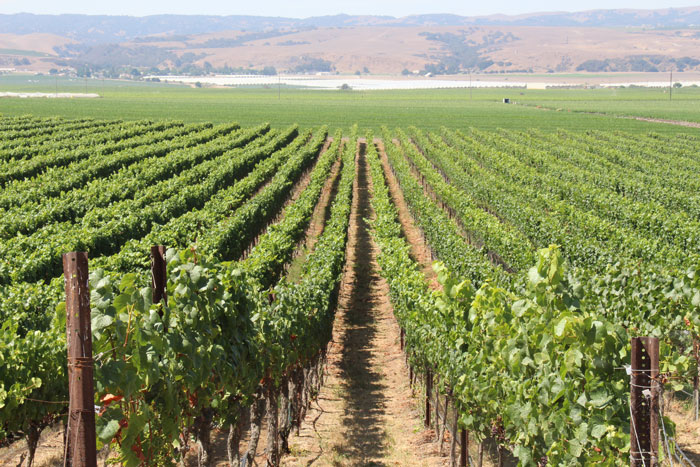
As the month of May drew to a close, the last of the vines in Brook Williams’ Duvarita Vineyard near Lompoc, Calif, had just finished blooming and the berries were continuing to swell. Most were at the BB stage but, on some clusters, they were nearing the size of peas.
Pinot Noir is the dominant variety he grows on the 26-acre Santa Barbara County vineyard, which also includes Chardonnay and Syrah along with some blocks of Pinot Gris and Viognier.
Up to this point, Williams’ 2015 crop has been lagging about two weeks behind last year’s accelerated pace, he notes. He attributes much of that to the weather. Most of May featured cooler and windier conditions than normal.
“Last year, we had 90-degree temperatures at the beginning of May,” Williams says. “This year, we had only one day when temperatures in May got above 70 degrees. Right now, although the tendrils keep reaching out, the canopies look kind of stunted. We’re not seeing the number of clusters per vine as we did last year.”
As the drought continues and Williams seeks to minimize water use, the likelihood of a smaller crop load this year isn’t exactly unwelcomed.
In fact, he’s taken several steps designed to minimize water demand in his drip-irrigated vineyard by limiting vine and fruit development. For example, this season he pruned weaker canes back to spurs and shoot-thinned more aggressively to concentrate canopy and crop.
Also last year, he installed soil moisture sensors to augment visual observations of the vines and pressure bomb results to better time the frequency and rate of irrigation. Last season was a learning process as he compared the soil sensor readings with the appearance of his vines. In the process, he learned that the water-holding capacity of his sandy loam soils was higher than expected.
“We went into this season assuming this will be another drought year,” he says. “Through our pruning, canopy and irrigation practices we’re trying to send the message to our vines to reduce the number of shoots per vine and cluster development. So far, we haven’t seen a lot of consistent canopy density and growth of shoots with three clusters on them. If anything, we’re seeing more single clusters per shoot than triples. In the process, we’ve used only half as much water for irrigation this year as we did last year during the same period.”
The cool weather in May has reduced the typically heavy pressure from powdery mildew in his organically-grown vineyard. “I’ve been surprised,” he says. “It’s much lighter than usual. So far, we’ve only had to make one sulfur application to treat the disease.”
During the early part of June, he’ll begin pulling leaves to let more air and light into the canopy and help dampen the powdery mildew threat, while improving color of the berries.
The number of vine mealybugs, his main insect pest threat, is also down this year, at least up to now, he reports.
“Usually, it’s heavier than it has been this year,” Williams says. “We use both mating disruption and an organic insecticide to catch any spots of activity before the mealybugs become a problem.”
When established in 2000, Duvarita Vineyard was planted in a way to protect the vines from the nearby ocean breezes and warm them with heat from the soil. The rows were spaced 7-feet apart, compared to customary wider row widths. Within the rows the vines were planted about three feet apart, which is a more little tighter than typical spacing.
Instead of placing the trellis wire about 2 ½ to 3 feet above the ground, the wires in this vineyard run about 20 inches above the soil surface. This is designed to shield the vines from winds and make better use of the heat and light reflected up to the grapes by the sandy soils.
Next year, Williams, who also owns Slide Hill Vineyard near San Luis Obispo, Calif., plans to expand his Duvarita Vineyard by another 35 acres. He’ll plant more Pinot Noir, Chardonnay, Syrah, Viognier, and add some Grenache and Mourvedre.
This year, drought has been Williams’ only real concern up to now.
“As far as producing a crop, conditions in the vineyard have been very nice,” he says. “A consistent growing season from here on out would be great.”
About the Author(s)
You May Also Like




